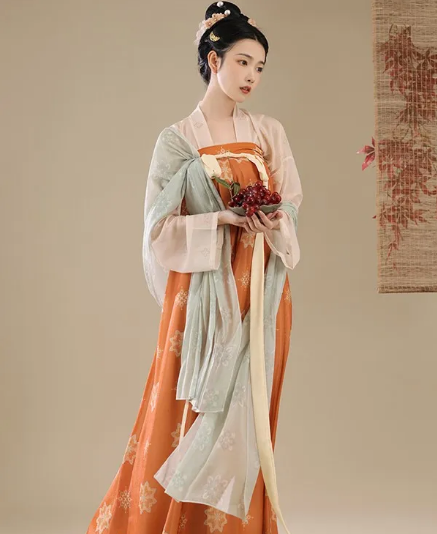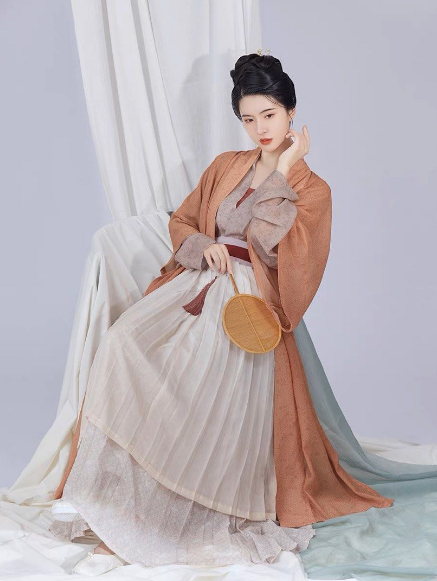Ming Dynasty Hanfu featured more modest, straight-lined designs with darker colors, distinct from the flamboyant Tang and elegant Song styles.
Historical Context of Ming Dynasty Hanfu
The Ming Dynasty, spanning from 1368 to 1644, marks a significant era in Chinese history, bringing forth dramatic transformations in culture, politics, and economics. During this time, Hanfu, the traditional attire of the Han Chinese, evolved notably, mirroring the dynasty’s unique ethos and aesthetics.
Overview of Ming Dynasty Era
Zhu Yuanzhang established the Ming Dynasty, ushering in a period of Han Chinese rule after the Mongol-led Yuan Dynasty. This era stands out for its robust economy, cultural renaissance, and advancements in technology and maritime exploration. Notable achievements of the Ming include the construction of the iconic Great Wall and the establishment of the Forbidden City in Beijing. The era also flourished in arts and literature, with Zheng He’s voyages symbolizing China’s naval prowess. Confucian ideals heavily influenced the Ming Dynasty’s social fabric, distinctly shaping the clothing styles of the period.

Evolution of Chinese Clothing Before Ming Dynasty
Before the Ming Dynasty, Chinese clothing styles varied greatly across different eras. In the Tang Dynasty (618-907), clothing featured lavishness and openness, with women wearing wide-sleeved robes and high-waisted skirts. The Song Dynasty (960-1279) introduced more conservative styles, reflecting the era’s Confucian values, with clothing becoming more restrained and less ornate. The Yuan Dynasty (1271-1368), under Mongol rulers, blended Mongolian attire into Hanfu, introducing garments like the yuanlingpao, a round-collared robe. The Ming Dynasty’s transition heralded a revival and redefinition of traditional Han clothing, aiming to restore Han Chinese cultural identity after the foreign rule of the Yuan.
Throughout these transformations, Hanfu consistently symbolized Chinese culture and identity, with each dynasty adding unique elements to the attire’s evolution. The Ming Dynasty, in particular, played a critical role in refining Hanfu, setting standards that have influenced Chinese clothing for centuries. For a more detailed exploration of Hanfu’s history and evolution, the Wikipedia page on Hanfu offers extensive information.
This background provides a foundation for understanding the unique characteristics of Ming Dynasty Hanfu and its distinctions from the styles of previous dynasties.
Distinctive Features of Ming Dynasty Hanfu
The Ming Dynasty Hanfu stands out for its unique features in fabrics, color schemes, and styles. These elements not only define the clothing’s aesthetics but also reflect the cultural and social norms of the period.
Fabric and Materials Used
During the Ming Dynasty, silk continued to be the predominant material for Hanfu, showcasing China’s advanced sericulture. Artisans incorporated various weaving techniques to produce different textures and sheens. The use of cotton also gained popularity due to its comfort and practicality. Notably, the introduction of new dyeing techniques allowed for brighter and more varied colors in fabrics. Brocade, a richly decorative shuttle-woven fabric, often adorned with embroidered patterns, became highly favored for formal garments, highlighting the era’s sophisticated textile skills.
Color Schemes and Symbolism
Color played a crucial role in Ming Dynasty Hanfu, with each hue carrying specific symbolic meanings. Red, considered auspicious, was widely used in wedding attire and imperial garments. Blue and black, often associated with commoners and working-class attire, mirrored the social hierarchy. Yellow, traditionally reserved for the emperor, reflected power and authority. These color choices were more than mere fashion statements; they were deeply rooted in Confucian and Taoist ideologies, emphasizing social order and harmony.
Clothing Styles and Silhouettes
The Ming Dynasty saw a diversification in Hanfu styles, catering to different social classes and occasions. The typical attire included robes, jackets, and skirts with varying lengths and widths. The silhouette of Ming Hanfu leaned towards straighter and simpler lines compared to the flamboyant styles of previous dynasties. Notably, the emergence of the stand-up collar and the wide-sleeved ‘daopao’ (robe) marked a departure from earlier designs. These changes not only provided comfort and ease of movement but also reflected the Ming Dynasty’s inclination towards practicality and modesty in fashion.
Each of these aspects of Ming Dynasty Hanfu, from the choice of fabric to the symbolism of colors and the evolution of styles, played a crucial role in shaping the identity and aesthetics of the era. For more in-depth details on traditional Chinese clothing, one can refer to the Wikipedia page on traditional Chinese clothing.
This comprehensive examination of Ming Dynasty Hanfu provides a clear picture of how clothing during this period was not just about fashion but a reflection of the socio-cultural milieu of the time.
Comparative Analysis of Hanfu Across Dynasties
This comparative analysis delves into the distinctive features of Hanfu across different Chinese dynasties, particularly focusing on the Ming Dynasty in comparison with the Tang and Song Dynasties.
Ming Dynasty vs. Tang Dynasty Hanfu
The Tang Dynasty (618-907) is renowned for its fashion liberation and flamboyance, a stark contrast to the Ming Dynasty’s more reserved styles. Tang Dynasty Hanfu featured wide sleeves, high-waisted skirts, and bold colors, reflecting the era’s cosmopolitan nature and cultural diversity. Women in the Tang Dynasty often wore ‘ruqun,’ a blouse and skirt combination, with the skirt sometimes having a high waistline. In contrast, the Ming Dynasty (1368-1644) embraced more straight-lined and modest designs, with clothing like the ‘aoqun,’ a jacket and skirt combination, representing a departure from the Tang’s extravagance. The Ming era favored darker colors and simpler patterns, mirroring the Confucian influence on social norms and aesthetics.
Ming Dynasty vs. Song Dynasty Hanfu
The Song Dynasty (960-1279) Hanfu was characterized by its simplicity and elegance, a trend somewhat continued by the Ming Dynasty. Song Hanfu often featured narrow sleeves and a more subdued color palette compared to the Tang Dynasty. However, the Ming Dynasty introduced variations like the stand-up collar and broader sleeves, adapting to practical needs while maintaining elegance. Women’s attire in the Song Dynasty often included ‘beizi,’ a long tunic, which the Ming Dynasty adapted into various forms, adding layers and altering lengths for differentiation.

Innovations in Ming Dynasty Hanfu
The Ming Dynasty brought several innovations in Hanfu, blending tradition with practicality. The introduction of cotton alongside silk provided more options for different social classes. The refinement in weaving and dyeing techniques led to more durable and vibrant fabrics. The Ming era also saw the standardization of Hanfu styles, with government regulations on clothing to reflect social status and occupation, a practice that had roots in earlier dynasties but became more pronounced during the Ming period.
Comparative Table
| Aspect | Ming Dynasty | Tang Dynasty | Song Dynasty |
|---|---|---|---|
| Style | Straight-lined, modest | Wide sleeves, high-waisted skirts | Simple, elegant |
| Colors | Darker, simpler patterns | Bold, vibrant | Subdued, narrow sleeves |
| Materials | Silk, cotton | Primarily silk | Silk, with some cotton |
| Innovations | Stand-up collar, broader sleeves | Flamboyant styles, cosmopolitan influence | Elegance in simplicity, narrow sleeves |
| Cultural Influence | Confucian ideals, practicality | Cultural diversity, fashion liberation | Confucian influence, simplicity |
This table provides a clear comparison of Hanfu styles across the Ming, Tang, and Song Dynasties, illustrating the evolution and distinctive characteristics of Chinese traditional clothing over time. For more comprehensive information on the history and evolution of Hanfu across these dynasties, the Wikipedia page on Hanfu offers detailed insights.
The analysis and this comparative table highlight the intricate relationship between fashion, culture, and society in ancient China, with each dynasty contributing uniquely to the rich tapestry of Chinese clothing history.
Cultural and Social Influences on Ming Dynasty Hanfu
The Ming Dynasty’s Hanfu was not just a fashion statement but a reflection of the intricate interplay between the era’s culture, politics, and society. The styles and elements of Hanfu during this period vividly illustrate the profound impact of social norms and artistic expressions.
Influence of Ming Dynasty Politics and Society
The Ming Dynasty’s political landscape significantly shaped its Hanfu styles. The dynasty’s adherence to Confucian values reinforced a social hierarchy, which was vividly reflected in the Hanfu’s design. Officials and nobility wore intricately designed robes with specific patterns that symbolized their status, while commoners adhered to simpler, more practical clothing. This distinction in clothing helped maintain the social order, a key aspect of Ming political ideology. The dynasty also enforced sumptuary laws, regulating the fabrics and colors that different social classes could wear, ensuring that clothing was a direct reflection of one’s social position.

Hanfu in Ming Dynasty Art and Literature
Hanfu during the Ming Dynasty also found prominent representation in the era’s art and literature, serving as a rich source for understanding the period’s fashion. Paintings and sculptures from the era often depict figures in elaborate Hanfu, providing insights into the styles and designs prevalent at the time. Literature, including poems and plays, frequently references Hanfu, sometimes using clothing as metaphors for character traits or societal values. For instance, in the famous Ming novel ‘Journey to the West,’ descriptions of characters’ attire offer glimpses into the intricate designs and cultural significance of Hanfu.
This exploration of the Ming Dynasty’s Hanfu reveals a deep connection between clothing and the broader cultural and social milieu. The Hanfu was not merely an article of clothing but a canvas that captured the essence of Ming society, its values, and its artistic expressions. For further reading on the cultural aspects of traditional Chinese clothing, the Wikipedia page on traditional Chinese clothing provides additional context and details.
Through this analysis, we see how Hanfu in the Ming Dynasty transcends its role as a mere fashion element, becoming a crucial part of the cultural and historical narrative of the era.







